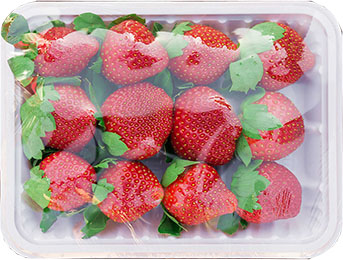Modified atmosphere packaging application - fruits and vegetables
Modified Atmosphere Packaging Application - Fruits and vegetables
Post Time: 21 October 2020

Consumers now expect fresh fruit and vegetable produce throughout the year. MAP has the potential to extend the safe shelf life of many fruits and vegetables. Packaging fresh and unprocessed fruits and vegetables poses many challenges for packaging technologists. As with all products, it is essential to work with the highest quality raw materials, and this is especially true for this product group, often referred to as fresh produce. The quality of fresh produce is markedly dependent on growing conditions, minimising bruising and other damage during harvesting and processing, adherence to good hygienic practices, controlling humidity to prevent desiccation while avoiding condensation to prevent mould growth, and maintaining optimum storage temperatures. Unlike other chilled perishable foods, fresh produce continues to respire after harvesting. The products of aerobic respiration include CO2 and water vapour. In addition, respiring fruits and vegetables produce C2H4 that promotes ripening and softening of tissues. The latter if not controlled will limit shelf life.
Respiration is affected by the intrinsic properties of fresh produce as well as various extrinsic factors, including ambient temperature. It is accepted that the potential shelf life of packed produce is inversely proportional to respiration rate. Respiration rate increases by a factor of 3–4 for every 10C increase in temperature. Hence, the goal of MAP for fruits and vegetables is to reduce respiration to extend shelf life while maintaining quality. Respiration can be reduced by lowering the temperature, lowering the O2 concentration, increasing the CO2 concentration and by the combined use of O2 depletion and CO2 enhancement of pack atmospheres. If the O2 concentration is reduced beyond a critical concentration, which is dependent on the species and cultivar, then anaerobic respiration will be initiated. The products of anaerobic respiration include ethanol, acetaldehyde and organic acids. Anaerobic respiration, or anaerobiosis, is usually associated with undesirable odours and flavours and a marked deterioration in product quality. While increasing the CO2 concentration will also inhibit respiration, high concentrations may cause damage in some species and cultivars.
Reducing O2 concentrations below 5% will slow the respiration rate of many fruits and vegetables. Kader et al. (1989) have tabulated the minimum O2 concentration tolerated by a range of fresh produce; while some cultivars of apples and pears can tolerate O2 concentrations as low as 0.5%, potatoes undergo anaerobic respiration at around 5% O2. In general, O2 concentrations below about 3% can induce anaerobic respiration in many species of fresh produce.
Elevated CO2 can also inhibit respiration. If the gas concentration is too high, then anaerobic respiration is induced with consequent quality problems. CO2 sensitivity is both species and cultivar dependant; strawberries are able to tolerate 15% CO2 whereas celery is stressed by CO2 concentrations above 2% (Kader et al., 1989). The tolerance of strawberries to CO2 can be used to inhibit the growth of the mould Botrytis cinerea.
The use of low concentrations of O2 and elevated levels of CO2 can have a synergistic effect on slowing down respiration and, indirectly, ripening. While the mechanisms whereby MAP can extend the shelf life of fresh produce are not fully understood, it is known that the low O2/high CO2 conditions reduce the conversion of chlorophyll to pheophytin, decrease the sensitivity of plant tissue to C2H4, inhibit the synthesis of carotenoids, reduce oxidative browning and discoloration and inhibit the growth of microorganisms. These mechanisms are all temperature dependent. The effects of MAP on the physiology of fruits and vegetables have been the subject of extensive research by many groups and have been well reviewed, e.g. Kader (1986).
Packaging technologists should be aware of several major pathogens as far as MAP fresh produce is concerned, in particular L. monocytogenes and C. botulinum. As previously discussed, L. monocytogenes can grow under reduced O2 levels and is not markedly inhibited by CO2. This
Combined with its ability to grow at temperatures close to 0C helps explain the concern.
The use of MAP atmospheres containing low concentrations of O2 and elevated CO2 concentrations may permit the growth of psychotropic protease negative strains of C. botulinum. However, provided packs are stored at 3C or below for not more than 10 days, there is unlikely to be a problem with clostridia. Temperature control is critical, since temperature abuse could lead to pack contents becoming toxic.
The environment in which fruits and vegetables are grown may harbor pathogens including Salmonella species, enterotoxigenic E. Coli and viruses. While these microorganisms may not grow in MAP packs, particularly if the storage temperature is maintained around 3C, they may survive throughout storage and could cause food poisoning through cross-contamination in the home or due to the consumption of raw or under-processed product. Hygienic preparation, sanitation in chilled-chlorinated water, rinsing and dewatering prior to MAP are now considered as essential treatments to fruits and vegetables prior to packaging to ensure low microbial counts and assure safety. Since there is a risk of anaerobic pathogens, such as C. botulinum, growing in MAP packs, a minimum level of O2 (e.g. 2–3%) is usually recommended to ensure that potentially hazardous conditions are not created.
Equilibrium MAP (refer to Chapter 2) has been used for fresh produce. Essentially, this involves using knowledge of the permeability characteristics of particular packaging films, along with the respiration characteristics of the product to balance the gas transfer rates of O2 and CO2 through the package with the respiration rate of the particular product.
Increasingly, gas packing fresh produce along with CO2/O2/N2 gas mixtures is being used. This approach may have benefit in reducing enzymic browning reactions before a passively generated equilibrium modified atmosphere has been established.
[SECTION B MAIN FOOD TYPES, Michael Mullan and Derek McDowell]